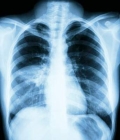For patients in early septic shock, goal-directed therapy based on continuously monitoring central venous oxygen saturation did not improve outcomes compared with standard care, according to a multicenter randomized trial reported in the New England Journal of Medicine and at the annual meeting of the International Society on Intensive Care and Emergency Medicine.
All-cause mortality at 90 days was 29% for both study arms, and costs of care were similar, reported Paul R. Mouncey of the Intensive Care National Audit and Research Centre, London, and his associates. The trial is the last of three planned studies of early, goal-directed therapy (EGDT), “all of which showed that EGDT was not superior to usual care,” the investigators wrote (N. Engl. J. Med. 2015 Mar. 17 [doi:10.1056/NEJMoa1500896]).
Support for EGDT originated mainly from a single-center, proof-of-concept study in 2001 by Dr. Emanuel Rivers and associates, who reported lower hospital mortality and length of stay when patients in early septic shock received 6 hours of treatment aimed at optimizing oxygen transport (N. Engl. J. Med. 2001;345:1368-77).
The protocol called for continuously monitoring central venous pressure, mean arterial pressure, and central venous oxygen saturation to guide use of intravenous fluids, vasoactive drugs, and red-cell transfusions. But uptake of EGDT has been limited, and clinicians have been concerned about the validity of the results and the complexity, risks, and costs of implementing EGDT, Mr. Mouncey and his associates said.
For the study, they randomized 1,260 patients with signs of early septic shock to either EGDT or standard care. All patients received intravenous antibiotics and adequate fluid resuscitation. The EGDT group also underwent a 6-hour resuscitation protocol that included monitoring central venous oxygen saturation, with additional treatment decisions left up to the treating clinician.
In all, 29.5% of patients who received EGDT died within 90 days, as did 29.2% of patients who received standard care (P = .90). The EGDT group received more intravenous fluids, vasoactive drugs, and red-cell transfusions and had significantly worse organ-failure scores, more days of advanced cardiovascular support, and longer ICU stays, but had no improvement in health-related quality of life or other secondary outcomes, the researchers reported.
“On average, EGDT increased costs, and the probability that it was cost-effective was below 20%,” they wrote. “Our results suggest that techniques used in usual resuscitation have evolved over the 15 years since the landmark study by Rivers et al.”
The United Kingdom National Institute for Health Research health technology assessment program funded the study. Nine coauthors reported receiving grants from the NIHR. One coauthor reported grants from ImaCor and Cheetah Medical. The other authors declared no relevant conflicts of interest.
acssurgerynews@frontlinemedcom.com




